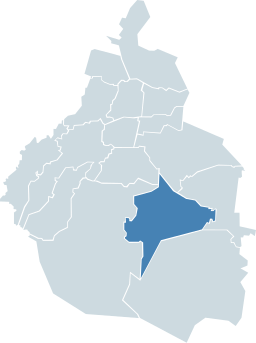Xochimilco | |
|---|---|
 Trajinera boats at Xochimilco | |
 Xochimilco within Mexico City | |
| Coordinates: 19°16′30″N 99°08′20″W / 19.27500°N 99.13889°W | |
| Country | Mexico |
| Federal entity | Mexico City |
| Seat | Av. Guadalupe I, Ramírez 5, Barrio El Rosario Nepantlatlaca, Xochimilco, 16070 |
| Time zone | UTC-6 (Zona Centro) |
| Website | xochimilco.cdmx.gob.mx |
| Official name | Historic Center of Mexico City and Xochimilco |
| Type | Cultural |
| Criteria | ii, iii, iv, v |
| Designated | 1987 (11th session) |
| Reference no. | 412 |
| Region | Latin America and the Caribbean |
Xochimilco (Spanish pronunciation: [sotʃiˈmilko]; Classical Nahuatl: Xōchimīlco, pronounced [ʃoːtʃiˈmiːlko] ) is a borough (demarcación territorial) of Mexico City. The borough is centered on the formerly independent city of Xochimilco, which was established on what was the southern shore of Lake Xochimilco in the precolonial period.
Today, the borough consists of the 18 barrios, or neighborhoods, of this city along with 14 pueblos, or villages, that surround it, covering an area of 125 km2 (48 sq mi). The borough is in the southeastern part of the city and has an identity that is separate from the historic center of Mexico City, due to its historic separation from that city during most of its history.
Xochimilco is best known for its canals, which are left from what was an extensive lake and canal system that connected most of the settlements of the Valley of Mexico. These canals, along with artificial islands called chinampas, attract tourists and other city residents to ride on colorful gondola-like boats called trajineras around the 170 km (110 mi) of canals. This canal and chinampa system, as a vestige of the area's precolonial past, has made Xochimilco a World Heritage Site. In 1950, Paramahansa Yogananda, in his Autobiography of a Yogi, wrote that if there were a scenic beauty contest, Xochimilco would get the first prize.[1]
- ^ "Chapter 21: We Visit Kashmir". Autobiography of a Yogi. Self Realization Fellowship.
